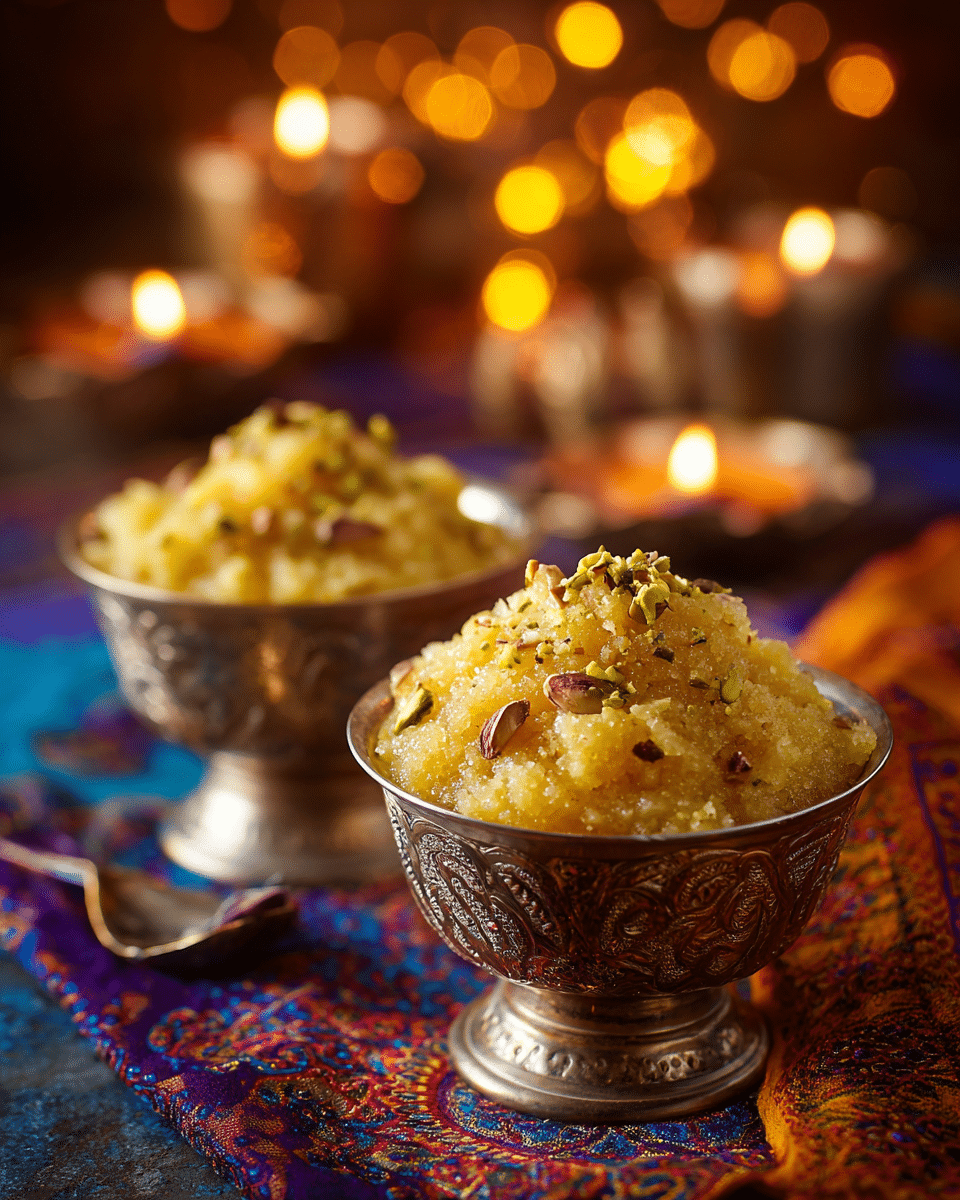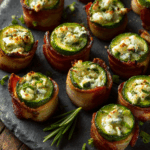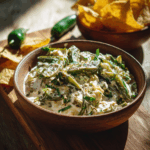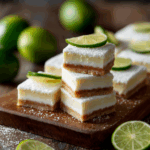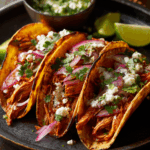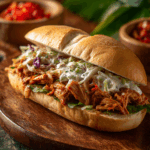Badam Halwa is a luxurious Indian dessert made from blanched almonds, ghee, sugar, and milk. Known for its rich texture and nutty aroma, this festive treat is traditionally served during celebrations and religious festivals. Its golden hue, enhanced by saffron and cardamom, makes it not just a dessert but an indulgent experience.
FULL RECIPE
Ingredients
- 1 cup raw almonds (badam)
- ¾ cup sugar
- ½ cup ghee (clarified butter)
- ¾ cup full-fat milk
- ¼ teaspoon cardamom powder
- A few strands of saffron (optional, soaked in 1 tablespoon warm milk)
- 1 tablespoon chopped pistachios or almonds (for garnish)
Directions
- Soak the almonds in hot water for 1 hour or overnight. Peel the skins and grind them into a smooth paste using milk.
- Heat 2 tablespoons of ghee in a heavy-bottomed pan. Add the almond paste and cook over low heat, stirring continuously.
- Cook the mixture until it thickens and starts to leave the sides of the pan. This may take 10–12 minutes.
- Add sugar and mix well. The mixture will loosen slightly. Keep stirring to avoid burning.
- Gradually add the remaining ghee in small batches while stirring. The halwa will begin to glisten and absorb the ghee.
- Add cardamom powder and saffron milk (if using). Mix well and cook for another 3–4 minutes.
- Turn off the heat when the halwa reaches a smooth, semi-solid consistency and ghee starts separating at the edges.
- Serve warm, garnished with chopped pistachios or almonds.
Nutrition Facts
- Calories: 320
- Total Fat: 21g
- Saturated Fat: 9g
- Cholesterol: 35mg
- Sodium: 5mg
- Total Carbohydrates: 26g
- Dietary Fiber: 2g
- Sugars: 22g
- Protein: 5g
- Calcium: 6% DV
- Iron: 5% DV
- Vitamin A: 4% DV
- Vitamin E: 15% DV
Cultural Significance of Badam Halwa
Badam Halwa holds a special place in Indian culinary tradition, often associated with festivals, weddings, and religious celebrations. This luxurious dessert is particularly prominent during Diwali and Holi, where it’s served as a gesture of warmth and hospitality. In South Indian households, it’s a symbol of festivity and is commonly included in wedding feasts or offered as prasad in temples. The richness of almonds and ghee reflects prosperity and abundance, which is why it’s favored during auspicious occasions. Its royal roots can be traced back to Mughal kitchens, where nut-based sweets were considered elite and indulgent.
Flavor Profile and Texture
Badam Halwa is known for its melt-in-the-mouth texture and rich, nutty flavor. The combination of blanched almonds and ghee creates a smooth, luxurious mouthfeel. The cardamom adds warm, aromatic notes, while saffron (if used) provides subtle floral undertones and a golden hue. The sugar complements the richness, making it sweet but not cloying. When perfectly cooked, the halwa is soft, slightly grainy from the almonds, and glossy from the ghee, offering a decadent treat with every spoonful.
Health Benefits of Almonds
Almonds, the star ingredient of Badam Halwa, are packed with nutrients. They are an excellent source of vitamin E, healthy monounsaturated fats, fiber, and protein. Almonds also support heart health, help regulate blood sugar, and are beneficial for brain function. While the halwa is indulgent and calorie-dense due to ghee and sugar, the presence of almonds adds a layer of nutritional value, making it a better choice than many processed desserts when eaten in moderation.
Customizations and Modern Variations
Badam Halwa is incredibly versatile and can be adapted to suit different tastes or dietary needs. For a dairy-free version, almond milk and coconut oil or vegan ghee can be substituted. To reduce sugar, natural sweeteners like jaggery or coconut sugar may be used, though they will slightly alter the flavor. Some modern variations incorporate a touch of rose water or saffron for a floral twist, or even blend in a bit of khoya or condensed milk for extra richness. You can also combine other nuts like cashews or pistachios for a mixed nut halwa version.
Serving Suggestions
Badam Halwa is best served warm, often spooned into small bowls or decorative ramekins. It can be garnished with slivers of almonds or pistachios for added crunch and visual appeal. For a festive look, edible silver or gold foil (varak) is often placed on top. You can also pair it with vanilla ice cream or kulfi to create a hot-and-cold dessert contrast. When served at gatherings, it is usually accompanied by a cup of masala chai or strong filter coffee to balance the sweetness.
Pairings and Complementary Dishes
When served as part of a larger Indian meal, Badam Halwa pairs well with savory mains like biryani, dal makhani, or rich curries. Its sweetness contrasts beautifully with spicy or tangy flavors, acting as a palate cleanser at the end of the meal. It also complements other traditional sweets like rasgulla or kaju katli when served as part of a dessert platter. For drinks, Indian beverages like chai, badam milk, or saffron lassi make excellent companions.
Storage and Shelf Life
Badam Halwa stores well and even improves in flavor over a day or two as the ingredients continue to meld. It can be kept in an airtight container in the refrigerator for up to a week. When ready to eat, it should be gently reheated on the stovetop or in the microwave with a splash of milk or water to restore its soft texture. For longer storage, you can freeze it in portioned containers for up to a month. Thaw overnight in the fridge before reheating.
Occasions to Serve Badam Halwa
This dessert is perfect for special occasions such as weddings, engagements, housewarmings, baby showers, and religious ceremonies. It also makes an excellent offering during Diwali, Navratri, Raksha Bandhan, and Eid. Its rich and luxurious nature makes it a thoughtful homemade gift when presented in decorative jars or boxes. Whether you’re hosting guests or marking a personal milestone, Badam Halwa adds a festive touch to any celebration.
Tips for Perfect Texture and Consistency
Achieving the ideal texture in Badam Halwa requires patience and attention to detail. Always use a heavy-bottomed pan to prevent burning, and stir continuously to ensure even cooking. The almond paste must be ground to a smooth but thick consistency—too much water will affect the final texture. Adding ghee in intervals instead of all at once helps the mixture absorb it properly and results in a glossy, non-greasy halwa. The cooking process should be slow and steady; rushing can lead to grainy or undercooked results.
Advertisement
Nutritional Considerations and Moderation
While Badam Halwa is nutrient-rich due to almonds, it is also calorie-dense because of ghee and sugar. It’s best enjoyed in moderation, especially for those watching their sugar or fat intake. Using less sugar or substituting with natural sweeteners can make it a slightly healthier option. Including small portions as part of a balanced meal or reserving it for special occasions allows you to enjoy its indulgent flavors without overindulging.
Conclusion
Badam Halwa is a timeless dessert that effortlessly bridges tradition and indulgence. Its rich flavor, smooth texture, and festive appeal make it a favorite during celebrations and cherished family gatherings. While it requires a bit of time and attention to prepare, the result is a decadent treat that showcases the beauty of simple ingredients like almonds, ghee, and cardamom. Whether you’re introducing it to new palates or reviving it for old memories, Badam Halwa remains a delightful symbol of warmth, celebration, and culinary heritage.

